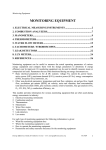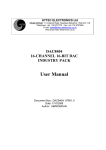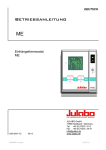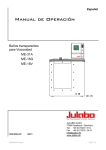Download JAW 1.041 Hardware User Manual Updated: Aug 30 2008
Transcript
JAW 1.041 Hardware User Manual Updated: Aug 30 2008 ****Caution: The Heat sink on the left hand side of JAW gets very hot. Please avoid touching it. JAW should be placed in an area where there is good airflow. Things to do before powering up JAW Check the resistance between TP1 and TP2, underside of PCB board, make sure the resistance is at-least 1k. Check the resistance between TP1 and TP3, underside of PCB board, make sure the resistance is at-least 1k. Turn R_RPM, the variable resistor, to the most counter clockwise position. The Heatsink on the lm317t carries 0-12v, make sure it is does not touch another voltage source. Wiring Fig. 1: Wiring Summary Jaw 1.041 Connects to Terminal # 1 12 [volt] Power 2 Ground 3 4 5 6 7 8 9 10 11 12 13 14 3-Bosch LSU 4- Bosch LSU 5- Bosch LSU 1- Bosch LSU 2- Bosch LSU 6- Bosch LSU Gauge/voltmeter/NB Gauge/voltmeter/NB RPM Pickup Analog input EGT +ve 5v output Notes Should be connected to a power source that is “live” only when vehicle is operational or when accessories power is enabled. Wire should be multi-stranded and rated for at least 3 amps Wire should be multi-stranded and rated for at least 3 amps 0-5v analog output 0-5v analog output Connects to tach signal 0-10v analog input Positive end of k type thermocouple You can tap this to power other 5v devices, keep an eye on the temperature of the lm7805, you do not want to over stress it. Wiring Bosch LSU 4.2 sensor Fig. 2 Fig. 3 On the Bosch connector there are 6 terminals; Fig. 3, on the opposite end there are 5 wires. Inside the connector, there is a laser cut calibration resistor, the terminal without a wire running out of it is connected to the resistor. Do not cut off the connector and run the sensor directly to JAW, you need the connector. Inside the Plug, where the metal terminals are, there are the terminal #s. Connect the sensor to JAW following Fig.4. Fig. 4: JAW-Bosch LSU 4.2 Wiring JAW Screw Bosch Connector Terminal # Terminal # 3 3 4 4 5 5 6 1 7 2 8 6 Wire Color leading to Head of Sensor Grey White Yellow Black This is the contact that has no wire directly leading to the sensor Red To connect to the sensor plug you can the terminal connections, Fig.5, which were sent to you are part of the JAW kit. See “Wideband_Cable_Construction_Guide_Cheap_Method,pdf”. Fig. 5 Alternatively you can order a harness, Fig.6, and use that. See “Wideband_Cable_Construction_Guide_Expensive_Method.pdf” Fig 6. Use multi-stranded wires, rated for atleast 3amps for connecting the sensor to JAW. Wiring EGT Probe For EGT you need a k-type thermocouple, ideally it should be the “grounded” kind. An example of a low cost EGT probe that is ideal for JAW is available here; http://www.omega.com/pptst/BTH-000_BTH-090.html The probe has 2 wires, negative and positive, usually the negative is a red wire and the positive is a yellow wire. Wire the probe to JAW following Fig. 6. Fig.6: JAW-EGT Wiring Jaw Screw Terminal # 2 (ground) 13 EGT Probe Negative, usually red colored Positive usually yellow colored Swapping the Negative and Positive wire will not damage the probe, so if you do not know which end is which, you can try both ways and see which works. Wiring RPM Before you hook up the rpm signal, make sure R_RPM; the variable resistor Fig. 7, is at the most counter-clockwise position possible. R_RPM is a current/voltage limiting variable resistor. Turning the variable resistor clockwise, the resistance falls. Turning the resistor counter clockwise will raise the resistance. R_RPM also forms a low-pass filter, which will smooth out any spikes on the RPM signal. The higher the resistance the greater the smoothing. The lower the resistance the less the smoothing. Always start off with the highest resistance possible, if you notice that JAW is reporting too low of an RPM, then you can lower the resistance until your RPMs read correctly. Fig. 7 Never turn the variable resistor to the most clockwise position, if you do so then will damage your JAW unit. For the RPM signal you can tap your tachometer or you can tap the low side of your primary ignition coil. Wiring LED Display unit The Display Connector on JAW, Fig. 9, connects to your first LED display according to Fig. 10 Fig. 9 Fig. 10: JAW-LED Display Wiring JAW 1.041 5v 5v Gnd Gnd Data Data CLK Clock Enable Enable Data In LED Display 1 For Daisy Chaining of up to 4 Display units, connect according to Fig. 11. The individual wires are not shown, each line between boxes represents 5 wires; 5V, gnd, Data, Clock, and Enable. Fig. 11: Display Daisy Chain Wiring LED Display 1 JAW 1.041 Data In Data Out LED Display 2 Data In Data Out LED Display 4 LED Disp 3 Data In The Device connected nearest to JAW, LED Display 1, will show AFR/Lambda. The second device on the chain, LED Display 2, will show EGT. The Third Device in the chain, LED Display 3, will show positive boost pressure. The forth device in the chain, LED Display 4, will Show RPM. Currently there is no customization of the Display order possible. If you want to show RPM then you must have 4 LED Displays attached, RPM will be shown on the last LED Display of the chain. If you just want to show AFR/Lambda, all you need is one LED Display unit. Sometimes the LED Display will glitch and you will get a very slow refresh. To fix this problem you need to disconnect the Display unit, wait a few minutes until the capacitor of the LED Display fully self-discharges, then reconnect the display. Alternatively you can disconnect the display and short the “5v” pin to the “gnd” pin, which will ensure that the capacitor is fully discharged and then reconnect the display. However, do not do not short the pins while the display is connected to JAW or you will damage the JAW unit and/or LED Display. The glitch usually occurs when a display is connected to JAW and/or each other while JAW is powered up. The proper way to connect the LED Display to JAW and/or each other, is to power off JAW first. Data Out Onboard LEDs There are 3 LEDs on the JAW 1.041 unit, Fig. 9. LED 3 indicates power. LED 1 and LED 2 indicate Wideband sensor temperature according to Fig. 12. Fig. 12: LEDs and Sensor Temperature Sensor Temperature LED 1 Too cool/Warming up On Perfect Off To Hot On LED 2 Off On On When JAW is in firmware update mode, all 3 LEDs will be on. Rescuing JAW from a bad flash update If problems occur during a flash update; power failure, data validation failure, disconnection of serial cable, etc…, and JAW is unable to accept another firmware update, you can force JAW to accept another firmware update. It is recommended that you disconnect the Bosch sensor when you are doing a firmware update. To force JAW into firmware update mode; press button “S1”, Fig. 7, while powering JAW up. When you are in firmware update mode, all 3 LEDs will be on. Once in firmware update mode, make sure that the next operation that you do is a firmware update via JAW Edit, do not do things like “query device” or change settings etc… Free Air Calibration Free Air Calibration uses the known oxygen content of air, 20.9%, to calibrate JAW so to be able to use aged sensors accurately. You must use Free Air, air that is not contaminated with exhaust gases. The best way to do this is to physically pull out the Bosch oxygen sensor from the exhaust. Before Calibration, make sure the sensor is warmed up and at the correct temperature. When the sensor is at the correct temperature, LED 1 will be off and LED2 will be on, Fig. 12. By clicking the “Calibration” button in JAW Edit, JAW will perform a free air calibration and save that calibration value to its internal memory. You can view the calibration value by clicking the “Get CalVal” button. You can edit the “CalVal” value and overwrite the Calibration value stored on JAWs internal memory by clicking the “Write CalVal” button. For a perfect sensor the calibration value should be very close to 0. If the value is negative that means that your sensor has the tendency to read too lean, the negative calibration value is applied to each AFR/Lambda sample to richen it up. A positive calibration value means that the sensor tends to read to rich, the positive calibration value is applied to each AFR/Lambda sample to lean it out. LED Display Unit Brightness On each LED Display unit is a variable resistor, R2, which sets the brightness of the LED Display. Turning the R2 clock wise will increase the brightness, turning it counter clockwise will lower the brightness. The limiting factor for how bright to set the display is the heat generated by the LM7805 voltage regulator, Fig. 13. The more LED Display units you daisy chain the more limiting the heat generated from the LM7805 becomes. You may put a heatsink on the LM7805 to deal with the heat, if so then you will want to buy a heatsink for the “T-220” IC package. The metal tab of the LM7805 carries 5v, so if you put a heatsink on it, make sure the heatsink does not touch another voltage source. Fig. 13 9v Battery Connector There is a 9v battery connector on JAW 1.041, it’s function is to supply JAW with power for those who do not have a laptop available and want to; download settings and firmware update, using a desktop computer. You can have a 9v battery and automotive 12v hooked up to JAW at the same time, JAW will just use the automotive 12v. If 9v is the only power source, the wideband sensor will not function as it draws too much current, everything else will function.
















